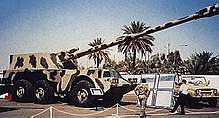Al-Fao

Al-Fao is a self-propelled artillery system designed for the former Iraqi Army by the late Canadian weapons engineer, Gerald Bull. It is one of the world's most powerful artillery pieces, with a caliber of 210 mm (8.3 in) and a range of 56 km (35 mi).[1] The Al-Fao system weighs 48 tons and can travel on roads with a top speed of about 72 km/h (45 mph). Its gun is claimed to be able to fire four 109 kg (240 lb) rounds a minute. The projectiles could be filled with chemical weapons such as sarin, mustard gas or phosgene, or with conventional high explosives.
The weapon is named after the Al-Faw peninsula in southern Iraq, which was the scene of heavy fighting during the Iran–Iraq War in the 1980s. (The difference in spelling is due to differing transliterations of the Arabic name.)
The Al-Fao was designed and built in Europe. It was similar in design to the South African G6 howitzer, with which Bull was also involved as a designer, and appears to have been directly inspired by that system.
It was first displayed publicly in Baghdad in 1989, but appears never to have entered into Iraqi service. None were captured during the 1991 Gulf War; the programme was probably cancelled thereafter.
See also
References
- ↑ "Saddam's Supergun And Verne's Columbiad" www.technovelgy.com., 12 October 2006. Retrieved 29 October 2011